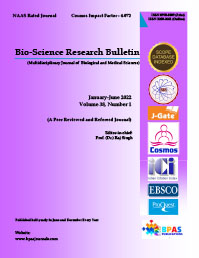Identification of Invasive Pest, Plautia corossota (Green stink bug) Using DNA Barcoding
DOI:
https://doi.org/10.48165/Keywords:
Plautia corossota, Green stink bug, DNA barcoding, Pentatomidae, CoI, GenbankAbstract
Plautia corossota, is a Heteropteran insect belonging to family Pentatomidae. A polyphagous insect, commonly known as the green stink bug, or shield bug, considered as a pest, is frequently found in and around local vegetables market of Chennai. To learn about its biology and to precisely identify the exact species, a specimen was collected from local terrain of Chennai. This insect is cosmopolitan is distribution, and is a serious pest known to infest almost all of the vegetable, fruit and commercial crops. No specific insecticide or effective pest management strategies are in place till date, probably due to obscure identification of pest species. This insect is polymorphous, and its identification simply based upon morphological features, may result in ambiguous, conclusions, and so a more scientific method, may be employed to ascertain its identity. Precise identification, of the insect pest is the key for developing pest management strategies, and so DNA barcoding was used for specific identification. The mitochondrial CoI was amplified using corresponding forward and reverse primers, and the query sequence was submitted to Genbank. (ID MF125272). Its relationship with other species of Pentatomidae, was ascertained, by constructing a Phylogenetic tree using the software MEGA, 5.2. Bootstarp values, using 500 replicates, were found to be 99% match with species such as Nezaraviridula voucher, Plautia crossota isolate U4c, Plautia crossota voucher ROPletc; of other green stink bugs. Tajima neutrality test D value was found to be 1.3, suggesting that the selection of this stink bug (Plautia corossota) was balanced.
References
Sharma, A., Sandhi, R.K. and Reddy, G.V.P. (2019). A Review of Interactions between Insect Biological Control Agents and Semiochemicals; Insects, 10, 439
Barman, A.K, Joyce, A. L., Torres, R. and Higbee, B. S. (2017). Assessing Genetic Diversity in Four Stink Bug Species, Chinavia hilaris, Chlorochroa uhleri, Chlorochroa sayi, and Thyantapallidovirens (Hemiptera: Pentatomidae), Using DNA Barcodes Journal of Economic Entomology, 110(6), 2590–2598
Chandra, K., Kushwaha, S. andTyagi, K. (2014). First record of four colour morphs of the southern green stink bug, Nezara viridula L. Heteroptera: Pentatomidae, from Madhya Pradesh, India. Munis Entomology and Zoology Journal, 9, 254-257
Esquivel, J. F., Brown,V. A., Harvey,R. B. andDroleskey,R. E. (2015). A black Color morph of adult Nezara viridula (L.). Southwest Entomology, 40, 649–652.
Fuxa, J. E., Fuxa, J. R., Richter, A. R. and Weidner, E. H. (2000). Prevalence of a trypanosomatid in the southern green stink bug, Nezara viridula. Journal of Eukaryotic Microbiology, 47, 388 394.
Greene, J. K., Turnipseed, S. G. and S ullivan, M. J. (1997). Treatment thresholdsfor stink bugs in transgenic B.t. cotton, pp. 895–898. In Proceedings, 1997 Beltwide Cotton Conferences, 6–10 January 1997, New Orleans, LA. National Cotton Council, Memphis, TN
Jadhav, D.D, and Hegde, V.D. (2018). On a collection of stink bugs (Hemiptera: Pentatomidae) in and around Pune, Maharashtra; Journal of Entomology and Zoology Studies,6(4), 1504-1507
Garcia Gonzalez, J., Giraldo Jaramillo, M., and Lopes, J. R. S. (2018). Undetected Infection by maize bushy stunt phytoplasma enhances host-plant preference to Dalbulusmaidis (Hemiptera: Cicadellidae). Environmental Entomology, 47(2), 396-402. doi:10.1093/ee/nvy001
Kalia S.I. Bistolas, Reid I. Sakamoto, José A.M. Fernandes and Shana K. Goffredi (2014) Symbiontpolyphyly, co-evolution, and necessity in pentatomid stinkbugs from CostaRica Frontiers in Microbiology, Volume5 Article349;1
Kiritani, K., Hokyo, N. and Kimura, K. (1966). Factors affecting the winter mortality in thesouthern green stink bug, Nezara viridula L. Annales de la Société Entomologique de France, Nouvelle Série, 2, 199–207. (Sunn Pest Memoirs, 9).
Lye, B. H., Story, R. N. and Wright, V. L. (1988). Southern green stink bug (Hemiptera:Pentatomidae) damage to fresh market tomatoes. Journal of Economic Entomology, 81, 189–194.
McPherson, J. E., and R. M. McPherson. (2000). Stink bugs of economic importance in North America & Mexico. CRC LLC, Boca Raton, FL.
More, S.V., Prashant, M.S., Kadolkar, S. and Kesarkar, V. (2017). Polymorphism in the southern green stink bug, Nezara viridula (L) (Hemiptera: Pentatomidae) From Chandgad Tehsil; International Journal of Zoology Studies, 2( 6),239-241
Morrill, A. W. (1910). Plant bugs injurious to cotton bolls. U.S. Dep. of Agriculture, Bureau of Entomology, 86, 1–110
Nault, B. A., and Speese, J. (2002). Major insect pests and economics of fresh-market tomato in eastern Virginia. Crop Protection, 21, 359–356.
Riberiro, A., and Castiglioni, E. (2008). Characterization of populations of natural enemies of Piezodorus guildinii (Westwood) (Hemiptera: Pentatomidae). Agrociencia, 12, 48–56. 17. Ruparao, T. (2018). India Entomophagy for nutritional security in India: potential and promotion Current Science, 115, (6), 25 September.
Salini S. (2011).Polymorphism in southern green stink bug, Nezara viridula L. Hemiptera: Pentatomidae. Current biotica., 4(2), 482-485.
Tsutsumi, T., Teshiba, M., Yamanaka, M., Ohira, Y. and Higuchi, T. (2003). An auto dissemination system for the controlof brown winged green bug, Plautia crossotas tali Scott (Heteroptera: Pentatomidae) by an entomopathogenic fungus, Beauveria bassiana E-9102 combined with aggregation pheromone. Jpn. J. Appl. Entomol. Zool., 47, 159–163
Todd, J. W., and D. C. Herzog. (1980). Sampling phytophagous Pentatomidae onsoybean, pp. 438–478. In M. Kogan and D. C. Herzog (eds.), Sampling methods in soybean entomology. Springer, New York.b
Underhill, G. W. (1934). The green stinkbug. Virginia Agriculture Experiment Station Bulletin,
: 1–26.
Vivan L.M. and Panizzi, A.R. (2002). Two new morphs of the Southern Green Stink Bug,
Nezara viridula L., Heteroptera: Pentatomidae, in Brazil. Neotropical Entomology, 51(3), 475-476.
Zalom, F. G., Smilanick, J. M. and Ehler, L. E. (1997). Fruit damage by stinkbug (Hemiptera:
Pentatomidae) in bush-type tomatoes. Journal of Economic Entomology, 90, 1300–1306
Zhang, J., Zhang, F., Gariepy, T., Mason, P., Gillespie, D., Talamas, E. and Haye, T. (2017).
Seasonal parasitism and host specificity of Trissolcus japonicus in northern China. Journal of
Pest Science, 904, 1127-1141.
